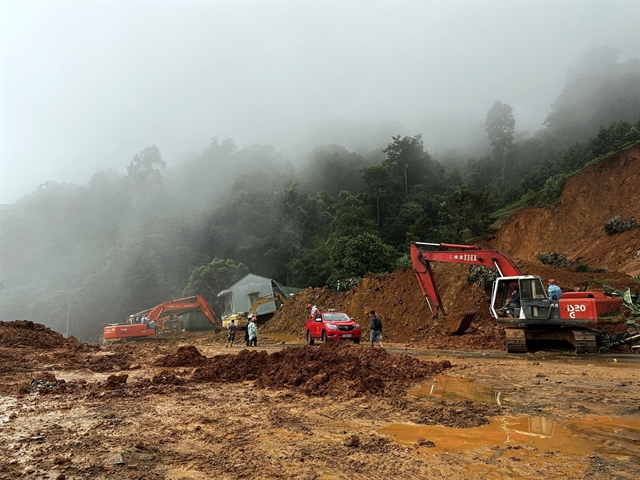 Environment
Environment
.jpg)

|
| The landslide occurs at the Bảo Lộc Pass in Lâm Đồng Province on Monday. — VNA/VNS Photo Nguyễn Dũng |
HÀ NỘI — Central Highlands provinces continue to see heavy rains leading to flooding and landslides in many places.
Gia Nghĩa City in Đắk Nông Province has three locations at risk of landslides. Local authorities gave warnings and are ready to evacuate people when necessary.
Nhân Cơ Commune and Kiến Đức Town in Đắk R’Lấp District have two roads with tens of metres of landslides, and are in danger of spreading.
Tuy Đức District also has four roads damaged. Soil and rocks blocked the road causing congestion.
Flood water flew over the Đắk Nông Hydropower Plant No 2, causing landslides with an area of about 300sq.m and about 10m deep.
Hundreds of residents in Đắk Nông Province felt worried when their house walls and floors cracked.
After two days of leaving Bu Krăk Village in Quảng Trực Commune, Thi Phí, 30, feels anxious and does not know when she can return to her house.
Her house is made of wood with a kitchen built of concrete. However, after prolonged rains on Tuesday, she saw many cracks on the floor and walls. She was told to seek refuge by authorities.
Local authorities moved 48 people to Gia Nghĩa City for safety.
Nguyễn Văn Thắng lives in Đông Thanh Commune, Lâm Hà District. He said his house was built for VNĐ3.7 billion (US$155,200) but was damaged after prolonged heavy rains. He was forced to move.
Statistics show that Đắk Nông Province has 163 landslides.
Deputy director of the Đắk Nông Department of Agriculture and Rural Development Lê Quang Dần said that to determine the causes of subsidence and landslides, careful geological research was needed.
"Protecting forests will limit natural disasters including landslides," said Dần.
On Thursday afternoon, after checking the subsidence around the Đông Thanh irrigation lake, chairman of Lâm Đồng People's Committee Trần Văn Hiệp requested a geological inspection.
Nguyễn Văn Quý, deputy director of the Đức Long Đắk Nông BOT and BT Joint-stock Company, said that the investor would hire a consulting unit to survey the geology of the entire area.
The Road Management Zone 3 Department reported to the Ministry of Transport that the left side of National Highway 14 had a landslide of about 300m.
Associate professor Trần Tân Văn, from the Institute of Geosciences and Minerals, said that cracks and subsidence were caused by long-term heavy rains.
"A crack is one of the first signs of a landslide,” he said.
Vũ Ngọc Long, former director of the Southern Institute of Ecology, said that the problem related to incorrect land use, farming, groundwater extraction and chemical use. They affected the natural ecosystem.
Many people planted high-yield and specialty crops without paying attention to safety. So, the vegetation disappeared. When it rains for a long time, the soil forms underground flows and the rock structure is broken leading to landslides, according to Long.
The overuse of chemical cleaning agents killed microorganisms that maintain the soil structure. The land will no longer be able to defend itself.
Regarding solutions, Long said that authorities must put the role of forests in combating climate change as priority. The agricultural sector should aim for safe and sustainable production. — VNS
.jpg)



